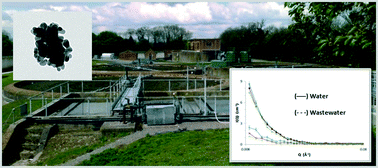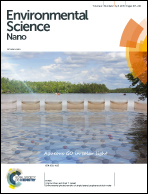Exploring controls on the fate of PVP-capped silver nanoparticles in primary wastewater treatment†
Abstract
Small-angle neutron scattering has been used to examine the settling behaviour of partially-passivated silver nanoparticles (AgNP), capped with a polyvinylpyrolidone (PVP) stabiliser, in water and domestic wastewater, in a primary clarification ‘microcosm’ as a function of time. The impact of two flocculants routinely used in the wastewater treatment process has also been studied. The settling velocity is found to be time-dependent, but always exceeds 100 mm h−1 during the first hour at the point of input. Particle removal by settling is almost three times greater in wastewater than it is in pure water. The results are rationalised in terms of a generic, but synergistic, interaction between non-ionic capping agents and anionic components of wastewater, and we show how this may afford an explanation for some of the diversity of behaviour previously reported in studies of several different NPs in wastewater treatment. We conclude that AgNPs entering primary clarification with non-ionic surface coatings, whether present by design or environmental transformation, pose no threat to the viability of the biofilms in secondary wastewater treatment.


 Please wait while we load your content...
Please wait while we load your content...